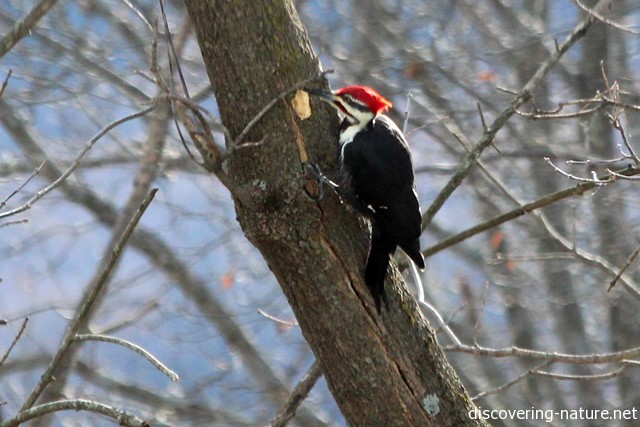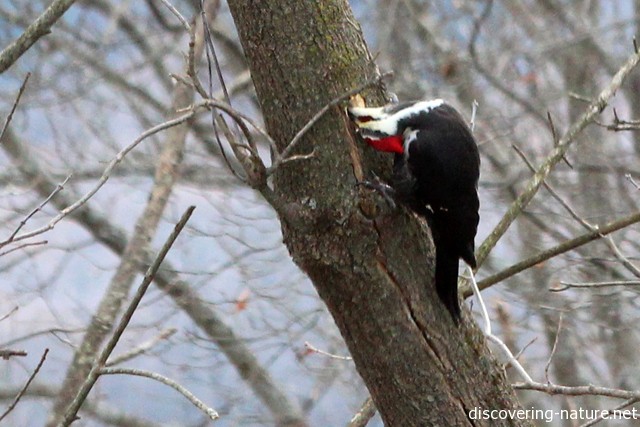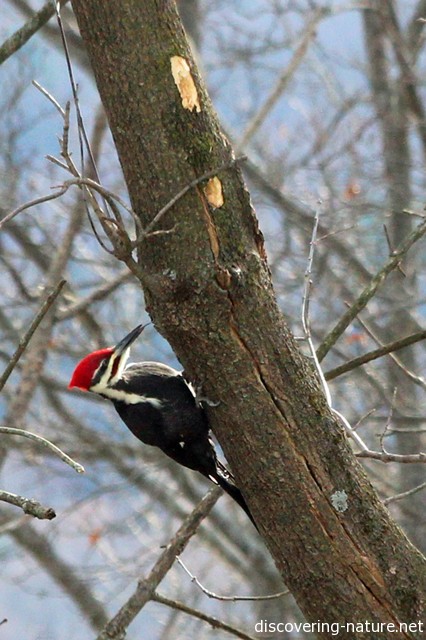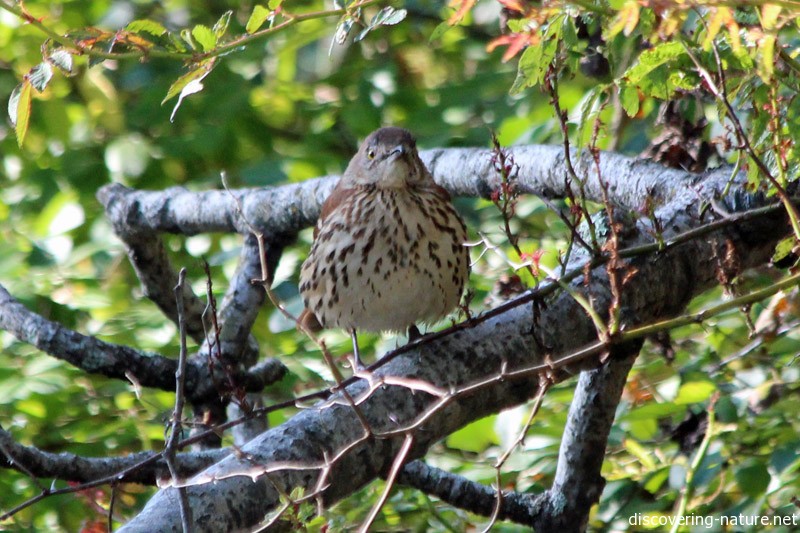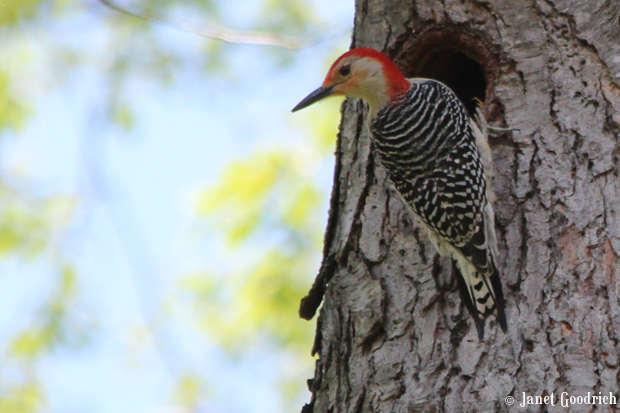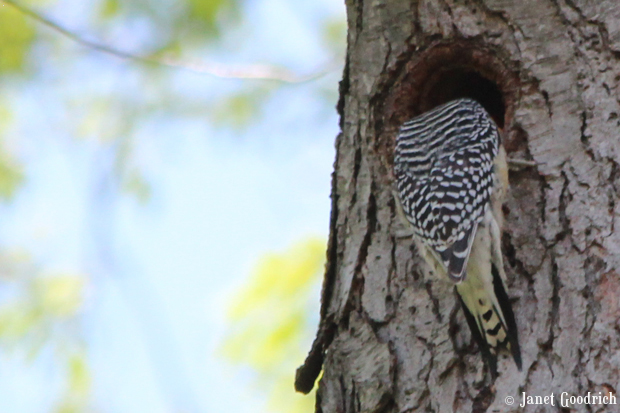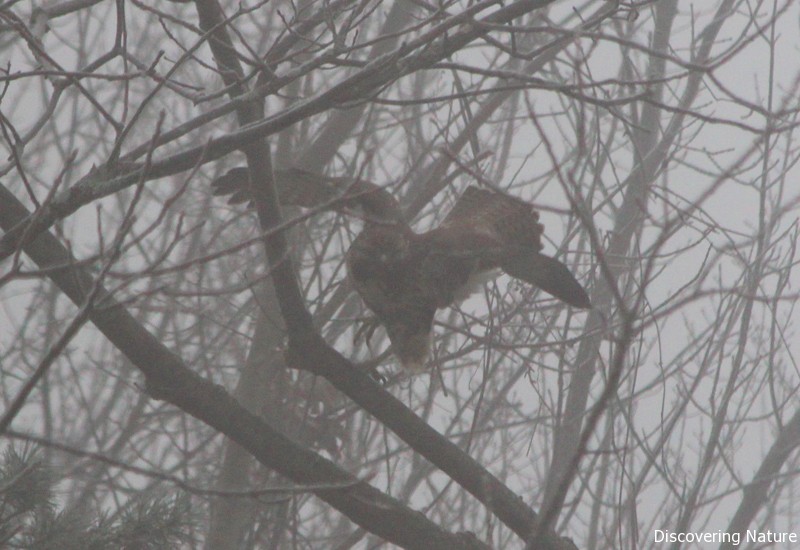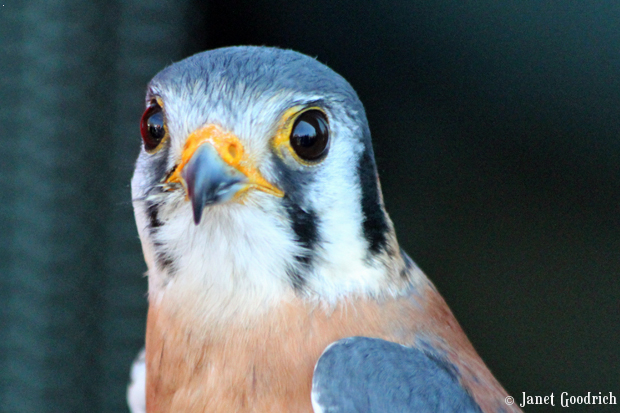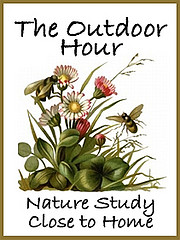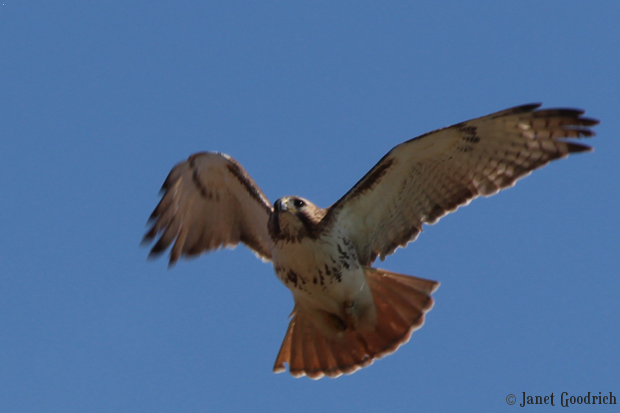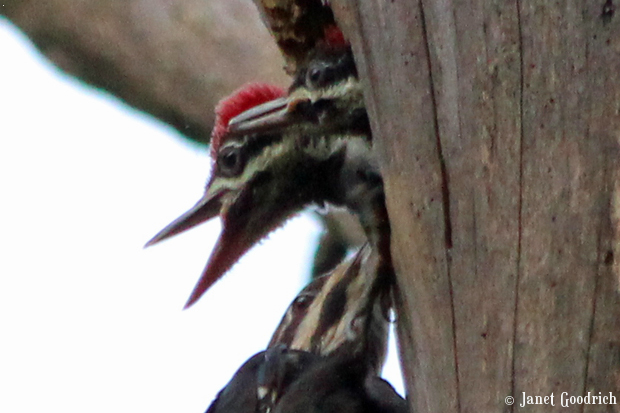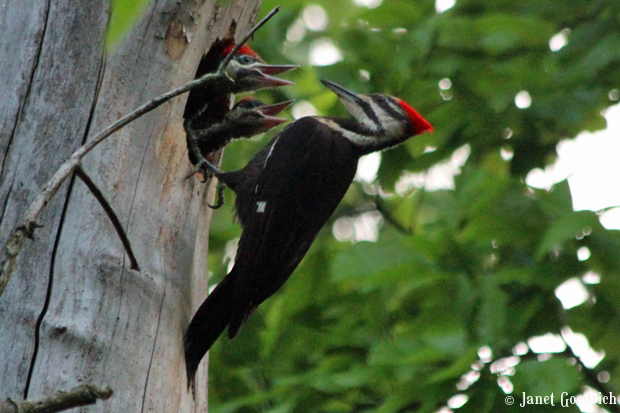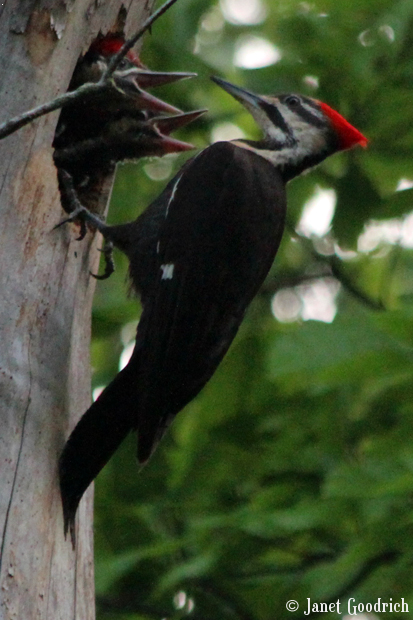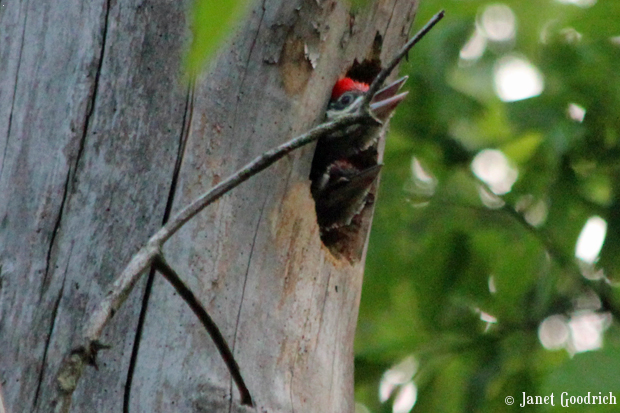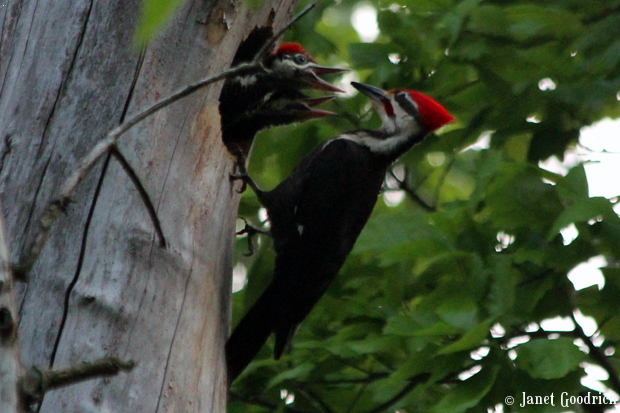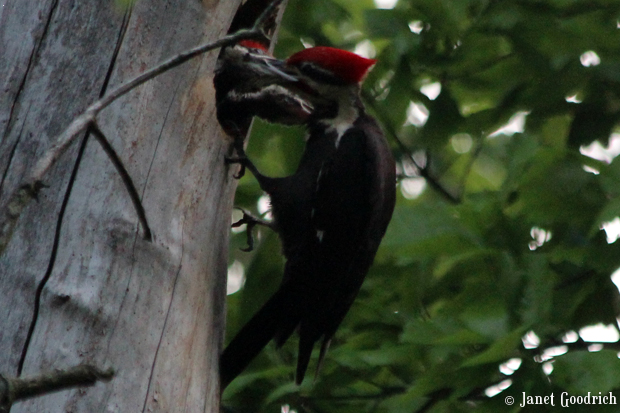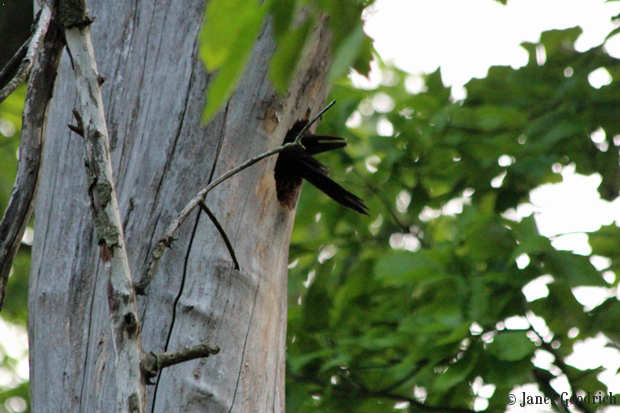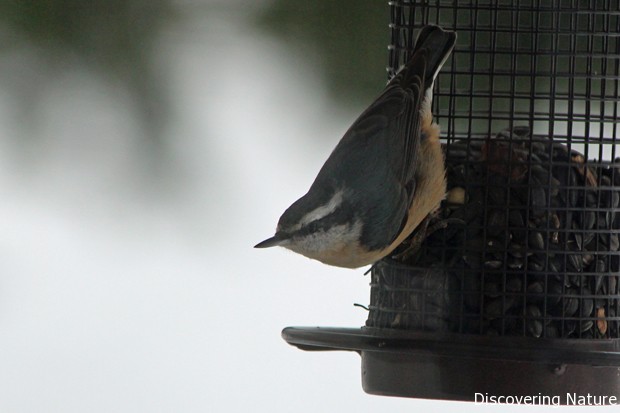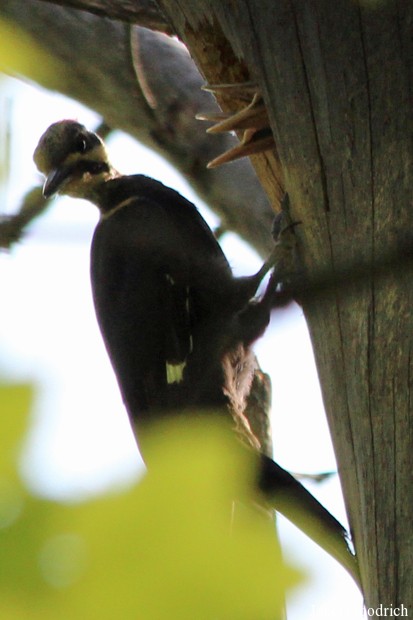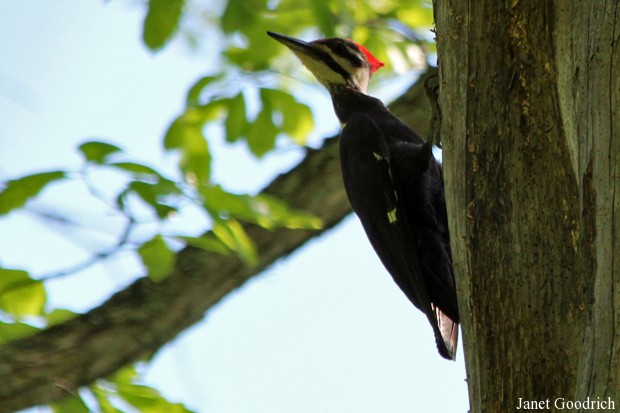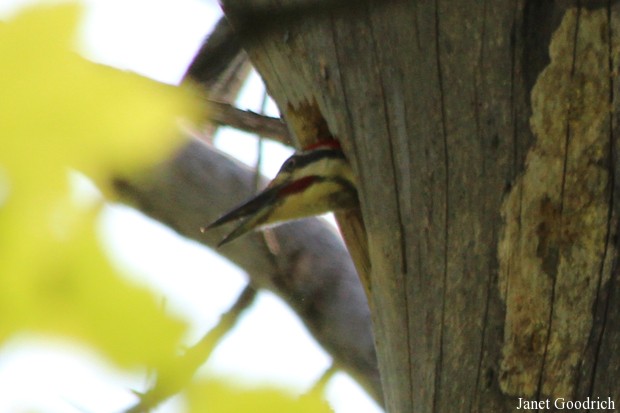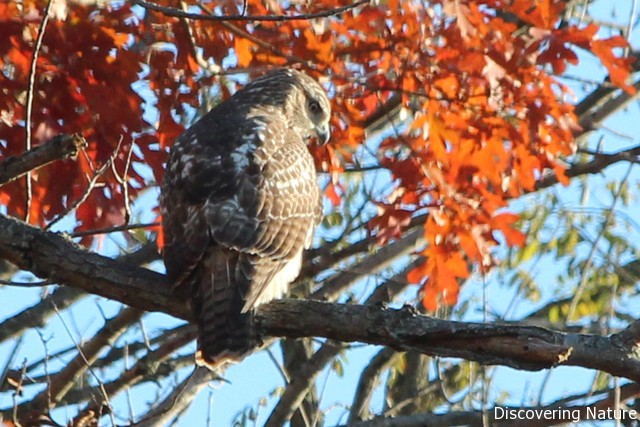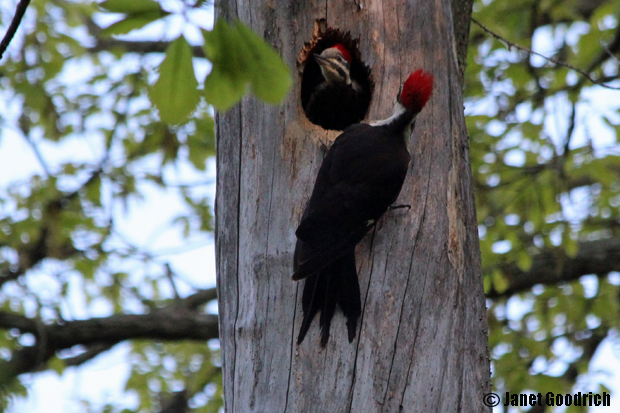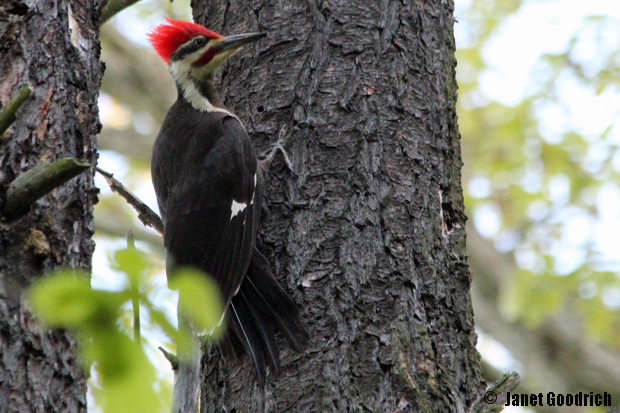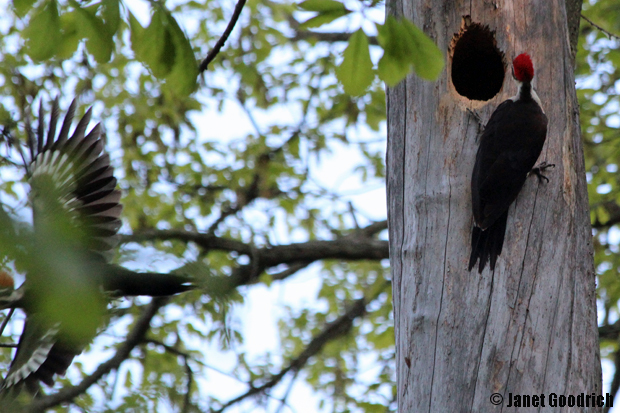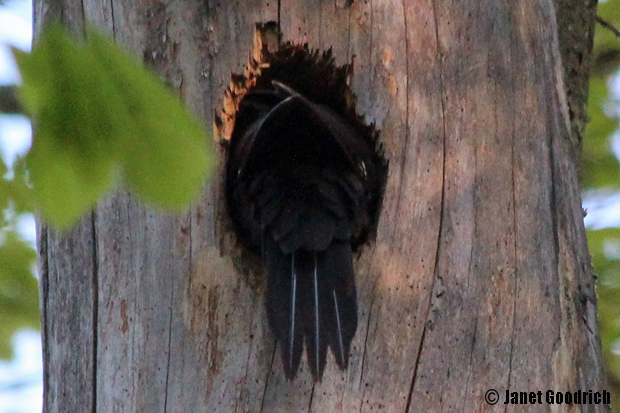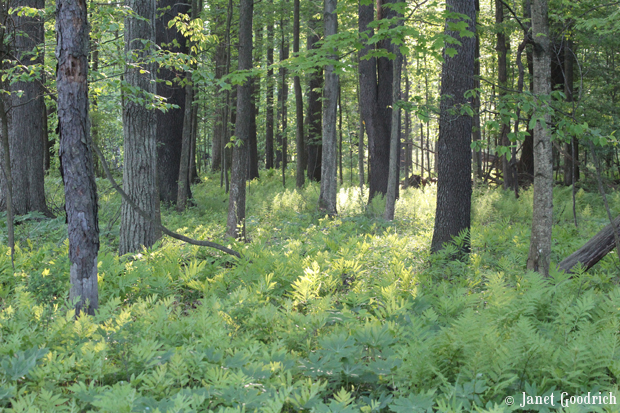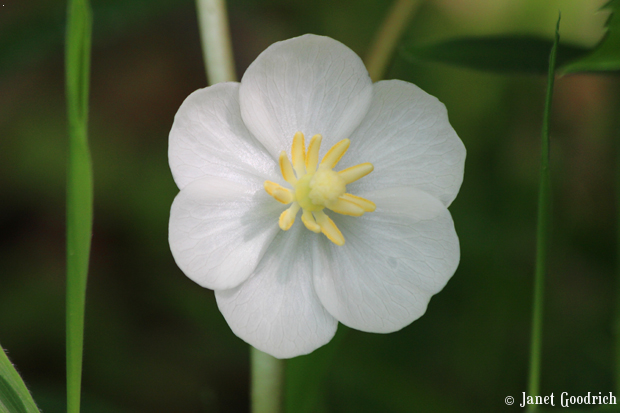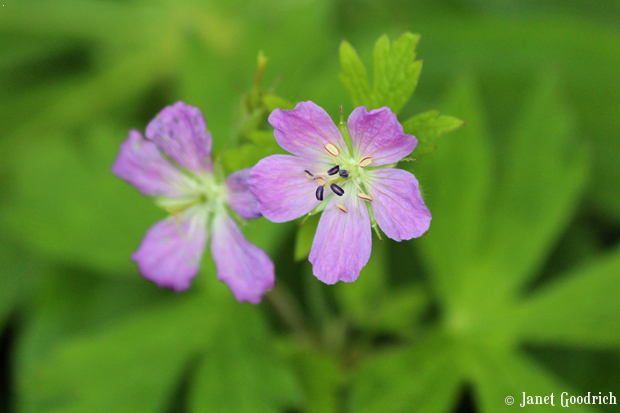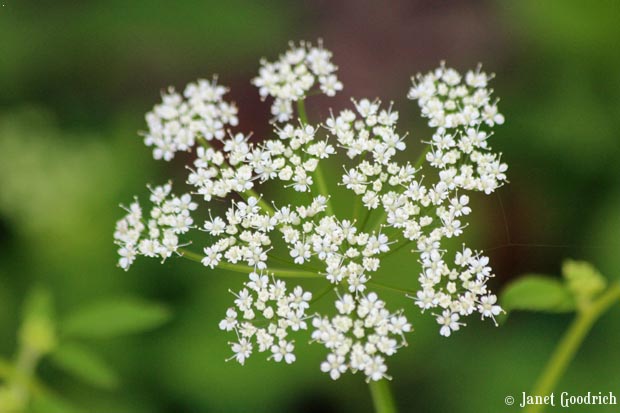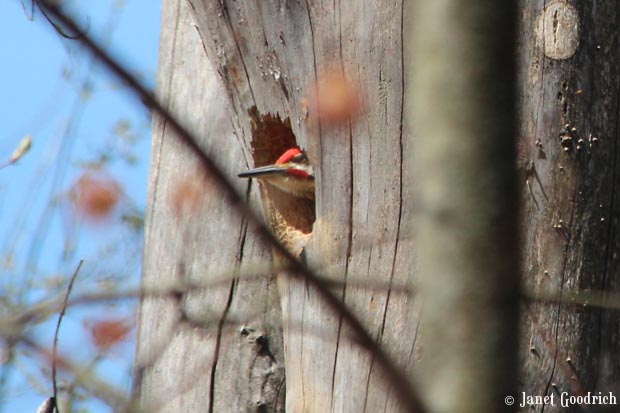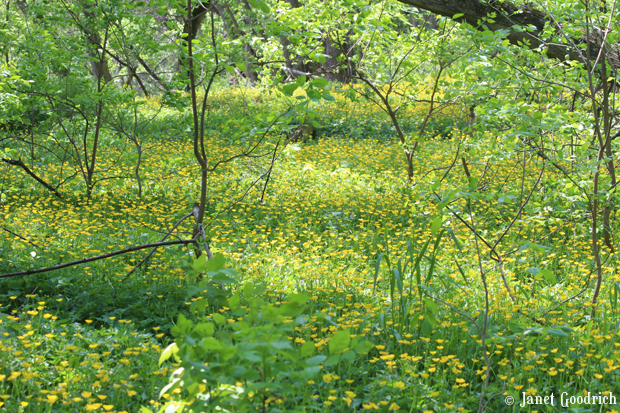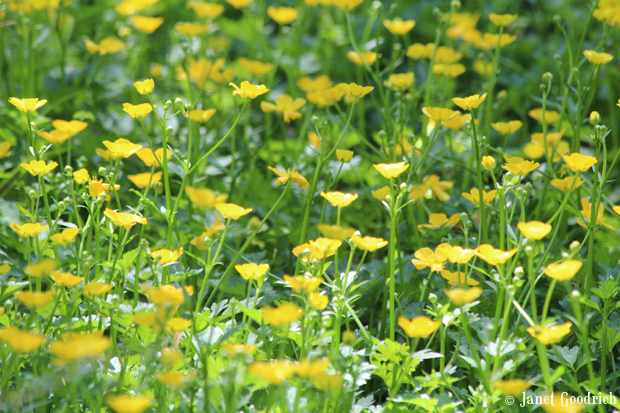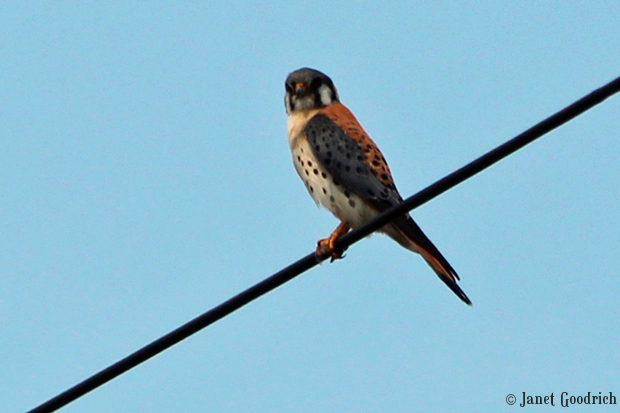-
Lunch
Yesterday I looked out the window while I was making lunch — and saw this.
I’ve often seen pileated woodpecker excavations in the woods and wondered what these large birds look like while they’re making them. How long do they stay in one place? How do they go about their work?
This fellow stayed for 15 minutes or so. He had been at work for a bit before I saw him, as the hole he was working on confirmed. It was amazing to see him hammering, pulling away bits of bark, and occasionally twisting his head to get at the bugs apparently deep inside the wood.
After awhile he hopped to the other side of the tree before flying away, giving me a glimpse of woodpecker tongue.
It doesn’t bode well for the tree; I’ve read that they only work on trees that are already dead or dying. But what fun to have him in the neighborhood! Now I want a larger suet feeder more than ever.
-
Mighty Mouse
On Tuesday we went to visit the site of a suspected red-bellied woodpecker nest cavity on one of our haunts. I wondered if we might see some nestling activity.
I took these pictures on May 11, and the bird appeared to be feeding young. We hadn’t been able to observe the site again, and I knew that by this time, there was a good chance that any possible woodpecker nestlings had fledged.
Turned out I was right. We saw nary a woodpecker… but this tufted titmouse came flying briskly out of the woodpecker hole!
I’m not sure if the titmouse is nesting in the woodpecker’s former home, or if it was just foraging for insects in there. We’ll have to check in again soon to see what we can find out.
It’s a brave looking little bird, isn’t it? — Looks like it feels ready for anything.
-
Outdoor Hour Challenge: Pileated Woodpeckers
Back in mid-April, my daughters and I stumbled upon a pileated woodpecker nest on one of our walks in the woods. We noticed not one, but two adult birds on a dead tree. The female flew away; the male went inside.
When we went past the spot in subsequent weeks, it seemed like nothing was going on there. But more recently it has become apparent that it was — and is — an active nest after all.
This is the female woodpecker, nearly as large as a crow, preparing to feed. The youngsters are a male (with the red sideburns), and a female (with black sideburns).
The male adult has more red overall — a red crest that reaches all the way down his forehead, and red sideburns.
 I’ve posted some pictures of feeding here, and of a nest exchange here.
I’ve posted some pictures of feeding here, and of a nest exchange here.The girls and I compiled a list of the most interesting things we’ve learned about pileateds:
- Their tongues coil all the way around their skulls and are long, sharp spears with backward-facing barbs that can be extended and retracted.
- Zygodactylus feet — two toes face forward, two face backward. (A fun new word to pull out from time to time!)
- The nestlings’ solid waste is in small packets that the parent birds carry away. (I witnessed this one morning after a feeding.)
- They are “forest engineers,” excavating cavities that other birds and mammals use for their homes.
- Their call sounds like the wilderness. One of their nicknames among the early settlers was “the laughing woodpecker,” and they do have an wild-sounding laugh — it makes me think of Bertha Rochester in the attic (Jane Eyre).
- A normal clutch is four eggs.
- The parents feed by regurgitating from their crops directly into the eager beaks of their young.
- The male ends up doing the majority of the incubating.
- They have sleeping cavities in trees, and often these holes have escape routes.
- One of their main foods is carpenter ants.
Though my reflex is to think of them as wilderness birds, they have adapted quite well to human “landscape engineering.” I know of three pairs nearby, so I guess this provides some anecdotal evidence. They’re often compared to ivory-billed woodpeckers, which have fared very differently and are now, probably, extinct.
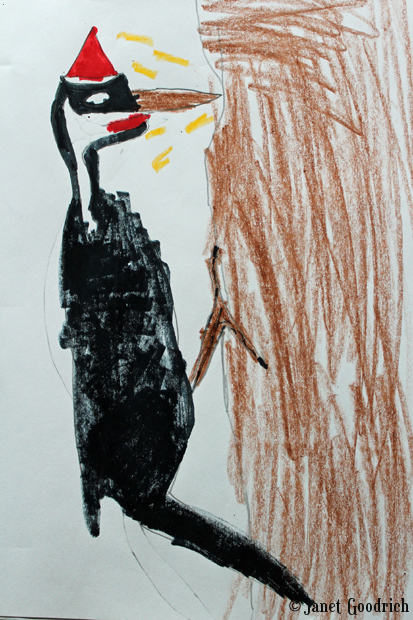
8-year-old's drawing 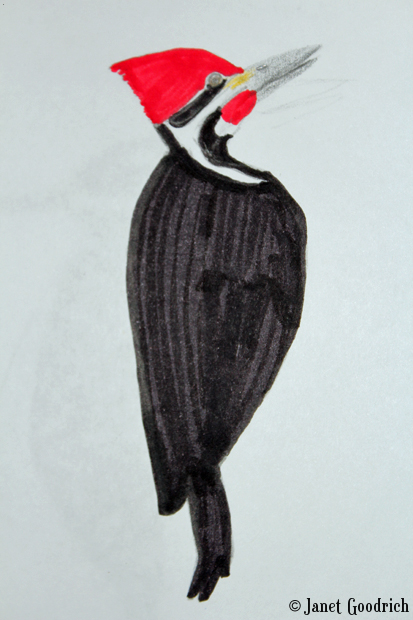
11-year-old's drawing Our favorite resources, in addition to observation, have been this website and several books, of which this one has been the most complete.
I remember hearing a pileated woodpecker while riding my bike a year ago, and working hard to get my first picture of one. It was far away and a little blurry, but I was completely thrilled. I never would have guessed the sights we had in store for us this year. If the trees had been fully leafed-out, we probably wouldn’t have seen this pair that day in April. And though the young make quite a racket begging for food when their parents are near, we might chalk the strange sound up to something else if we didn’t know the source. It’s been a good reminder for us to keep an open mind and alert senses in the woods.
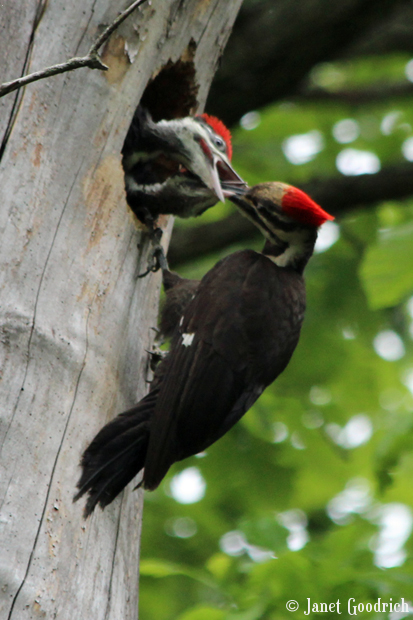
Feeding can be a hazardous occupation... I’m submitting this post to the Outdoor Hour Challenge, a great round-up of nature-study postings each month.
-
Pileated Woodpecker Feeding
I watched the pileated woodpeckers feeding their young yesterday morning. The sun was just peeking over the horizon, and I was still rustling around in dry leaves trying to find a good spot to settle, when the female showed up.
The youngsters made an incredible racket declaring their ravenous appetites, sounding like a combination of rasping hinge and buzzing insect. When she left, they continued calling for food.
The male came next, regurgitating directly into their beaks with his own formidable tweezers. (He came quickly, before I had time to move so that twig wasn’t in the way…)
How does he dare thrust in, open-eyed, among those stabbing beaks?
Unlike the female, when he finished the feeding he pushed the young back inside.
Normal clutch size is four eggs, but I’ve seen only these two young woodpeckers. Maybe there were only two successful eggs. Or maybe a predator has gotten the other two — a snake or an owl, either of which could reach into the cavity. It’s not a possibility I like to think about.
What an amazing experience to get to see the feeding! A year ago I never would have dreamed of it — I would have heard the occasional pileated call and felt a thrill, but the idea of seeing this kind of activity close in wouldn’t even have occurred to me.
The only disappointment is the graininess of my pictures in the low-light conditions. Maybe I will get another try some sunny blue day, when the sun is higher in the sky. But it’s hard to imagine two such opportunities… and the time is getting short. These young’uns seem like they must be close to fledging.
-
Beaks!
Just after I expressed my wish to see little beaks at some point at the pileated nest, I did!
My husband and kids and I were taking my parents for a walk along the trail, and Mrs. P appeared.
She was there for a few minutes, then left. Mr P appeared then and went inside — briefly.
I’ve read that clutch size is typically 4 eggs, though it can vary. It’s likely that there are more youngsters in there.
I also read that adults have yellow eyes. This is true of the male, but the female’s eyes look pretty dark. But I’ll reserve judgment unless and until I get some better pictures.
This site is helpful on pileated woodpeckers.
-
Pileated Pair
Yesterday I crouched in ferny woods for 45 minutes or so, waiting for the pileated woodpeckers to show themselves. It was 6:30 in the morning when I settled myself on a damp fallen log in the tick-infested woods, within view of the nest, but not too close.
I watched red-winged blackbirds chasing one another and sounding off. A broad-winged hawk lit on a branch over my head and gave me one brief, piercing look before taking flight to escape some marauding grackels. By 7:00 I was getting chilled, my feet were falling asleep, and my trick neck was threatening to jam as I looked up wistfully at the woodpecker cavity.
Suddenly, Mrs. Pileated appeared, a silhouette against the sky on a neighboring tree. She pecked away quietly, making sure the coast was clear, then whooshed to the tree and went inside.
She wasn’t in there long before Mr. Pileated appeared. He surveyed the scene carefully from several different trees, including one right in front of me.
Then he made his move.
I left, being careful to use a different route than the one I took coming in.
It was thrilling. I think of pileated woodpeckers as belonging to the wilderness, and I felt privileged to see them going through their routines together. I still haven’t seen any little beaks poking out. How many nestlings do they have? When will they fledge? I don’t want to hound them by coming too often, but I hope I’ll see a glimpse of the youngsters at some point. I’ve never seen a juvenile pileated woodpecker.
What is it that drives me to such an activity early on a Saturday morning? I’ve been thinking about it today. My woodland explorations have come to seem like some of the most real moments of my life. It’s the ultimate “unplugged” experience, for one thing. The sights and sounds and smells are all vivid and direct. For another, there is no pretense in nature. All around me are creatures busy at the task of survival. They need food; they need to mate and raise young; they need to stake out territory to provide for themselves. It’s life and death for them, and it exposes many of my human rituals and “concerns” as simply trivial. Which brings us to humility. It’s humbling to get these glimpses of the complexity and variety and beauty of the non-human world. Humbling, and deeply inspiring.
What better way could there be to start a weekend?
-
A walk in the sun
The girls and I drank in the sunshine yesterday with a saunter through the woods.
Every time we come here, we see new wildflowers appearing. This time we saw May apple.
Apparently the flower will morph into a yellow berry that can be made into jelly. (The rest of the plant is poisonous.) I’ve noticed the broad-leaved plant for a few weeks now, carpeting the ground, but this was the first time we saw the blooms.
Here’s how it looked two weeks ago.

May apple in early May This delicate flower is apparently wild geranium.
Queen Anne’s Lace makes me sneeze, but I think it’s quite pretty — not as threadbare as it looks as first glance.
We were on our way to check on the pileated woodpecker nest we discovered in April. This photo was taken on April 19, and I haven’t surpassed it — yet.
At this point I assume the adult birds are feeding youngsters. One of these days, I hope to see some little beaks poking out. But for now we content ourselves with seeing the adult birds flying to the cavity and disappearing inside, or suddenly bursting out and flying away. It must be some deep cavity! These are large birds, and presumably there are nestlings in there too, but you can’t see any trace of them inside.
We did see the adult birds change shifts — the female arrived and the male flew off. On our way in we received another treat: a chance to watch a Northern flicker excavating a nesting cavity.

Northern Flicker 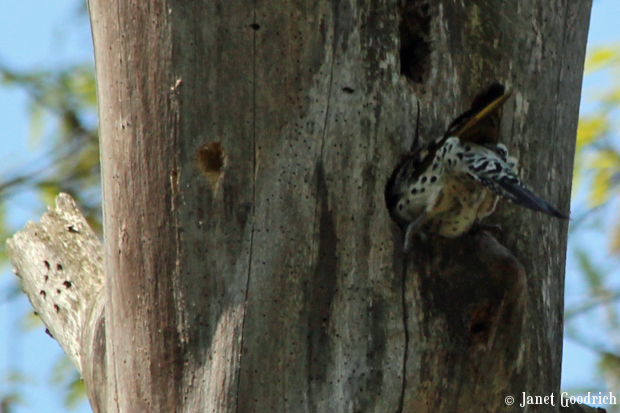
Flicker fanny... 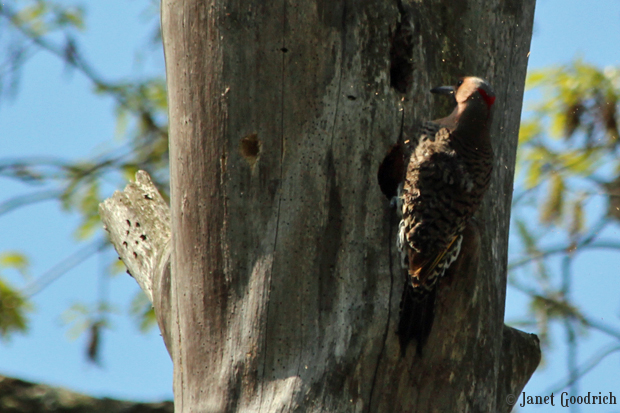
Flicker shaking off particles of sawdust before ducking inside for more excavating. I read that these birds are in decline. Starlings compete for their nesting sites and usually win. It made the knowledge of this nest all the more exciting. This is the fourth nest we’ve discovered: the robin in our front shrub, the pileated pair, a red-bellied woodpecker nest at another site, and now the flicker. There’s a feeling of privilege in being able to observe such things.
The day was so nice that we took another short stroll at a different place. We stumbled upon a buttercup carpet.
These are just a few of the sights and sounds we enjoyed. We also saw many yellow warblers, mockingbirds, catbirds, robins, chipping sparrows and song sparrows and tree swallows. Off in the woods, we heard a hermit thrush sing its rippling, echoing song. A Baltimore oriole flitted about in the treetops overhead, warbling conversationally.
Beauty everywhere. It was inspiring and quieting in the best ways.


